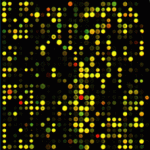Genomics
|
8 may 2012 17:07:48 |
| Construction of physical maps for the sex-specific regions of papaya sex chromosomes (BMC Genomics) |
|
Tweet Background:
Papaya is a major fruit crop in tropical and subtropical regions worldwide. It is trioecious with three sex forms: male, female, and hermaphrodite. Sex determination is controlled by a pair of nascent sex chromosomes with two slightly different Y chromosomes, Y for male and Yh for hermaphrodite. The sex chromosome genotypes are XY (male), XYh (hermaphrodite), and XX (female). The papaya hermaphrodite-specific Yh chromosome region (HSY) is pericentromeric and heterochromatic. Physical mapping of HSY and its X counterpart is essential for sequencing these regions and uncovering the early events of sex chromosome evolution and to identify the sex determination genes for crop improvement.
Results:
A reiterate chromosome walking strategy was applied to construct the two physical maps with three bacterial artificial chromosome (BAC) libraries. The HSY physical map consists of 68 overlapped BACs on the minimum tiling path, and covers all four HSY specific Knobs. One gap remained in the region of Knob 1, the only knob structure shared between HSY and X, due to the lack of HSY-specific sequences. This gap was filled on the physical map of the HSY corresponding region in the X chromosome. The X physical map consists of 44 BACs on the minimum tiling path with one gap remaining in the middle, due to the nature of highly repetitive sequences. This gap was filled on the HSY physical map. The borders of the non-recombining HSY were defined genetically by fine mapping using 1460 F2 individuals. The genetically defined HSY spanned approximately 8.5 Mb, whereas its X counterpart extended about 5.4 Mb including a 900 Kb region containing the Knob 1 shared by the HSY and X. The 8.5 Mb HSY corresponds to 4.5 Mb of its X counterpart, showing 4 Mb (89%) DNA sequence expansion.
Conclusion:
The 89% increase of DNA sequence in HSY indicates rapid expansion of the Yh chromosome after genetic recombination was suppressed 2-3 million years ago. The genetically defined borders coincide with the common BACs on the minimum tiling paths of HSY and X. The minimum tiling paths of HSY and its X counterpart are being used for sequencing these X and Yh-specific regions. |
| 242 viewsCategory: Genomics |
 Phylogenomic analysis of UDP glycosyltransferase 1 multigene family in Linum usitatissimum identified genes with varied expression patterns (BMC Genomics) Phylogenomic analysis of UDP glycosyltransferase 1 multigene family in Linum usitatissimum identified genes with varied expression patterns (BMC Genomics)Improving ancient DNA read mapping against modern reference genomes (BMC Genomics) 
|
| blog comments powered by Disqus |
MyJournals.org
The latest issues of all your favorite science journals on one page
The latest issues of all your favorite science journals on one page



